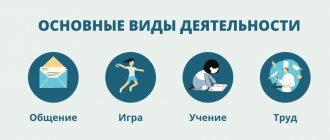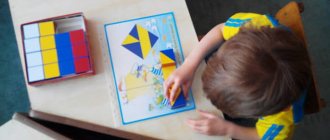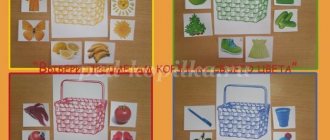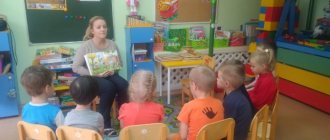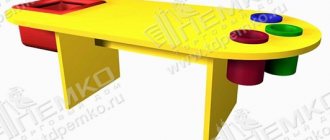Author information
Voskobovich's method in kindergarten is used for the comprehensive development of children's creative abilities. Children who study according to the method perform mathematical operations faster than their peers, begin to read early, are able to perform creative activities and think logically, can concentrate attention and have a good memory.
The author of the method, Vyacheslav Voskobovich, had nothing to do with psychology and pedagogy for many years. By profession he is a physics engineer. In addition to physics, Voskobovich was interested in music, wrote songs for children and adults, and was partial to poetry. His own children pushed him to create the technique. In the early nineties, it was very difficult to purchase high-quality games for the development of logic, thinking, memory and educational materials. Then Vyacheslav Voskobovich independently developed a series of games and successfully adapted it.
Educational games are universal aids that can be used repeatedly with equal success. Subsequently, a whole teaching methodology was developed based on several games, aimed at the comprehensive development of the child. At the moment, you can familiarize yourself with more than fifty games and a large number of educational aids. In Russia and neighboring countries, Vyacheslav Voskobovich’s author’s seminars are regularly held, and in kindergartens the methodology is actively being introduced into the process of learning and development.
Why choose Voskobovich's games
- The games are based on fairy tales. In the game, the child helps fairy-tale characters by completing certain tasks. The plot of the fairy tale captivates and does not allow you to quit halfway. Training is entirely subordinated to a fairy tale plot. In addition, fairy tales always teach good things. You can always abandon the fairy-tale basis of the game or come up with your own.
- The main goal of Voskobovich’s games is to develop the child’s intelligence. They are structured in such a way that each subsequent task slightly exceeds the child’s capabilities (from the zone of proximal development).
- Any game by Voskobovich develops fine motor skills, spatial and logical thinking, combinatorics, imagination, and reveals creative potential. Games affect memory, attention and perseverance.
- In addition to development, including intellectual development, the goal of every game is learning. But adults know about this, not children. Children learn “accidentally” through play. This method of teaching is the only correct one in preschool age. Each game teaches something special: reading, counting, numbers, letters, colors, shapes, or several concepts at once.
- Voskobovich’s method can be combined with any other developmental method, because it is useful for any child to buy a new game.
- Children who play Voskobovich's games begin to read and count early, have good memory, perseverance, developed imagination and a stable psyche. They learn easily at school.
- In Voskobovich's games there is no place for adult violence against a child. The image of a strict teacher is impossible in the game: all players are equal. The parent’s task is to explain the rules of the game and play with the baby or observe, guide, and ask questions.
- Games form a lifelong style of communication between parent and child: cooperation, partnership based on mutual interest, and not mentoring, adult supremacy.
- Even an inexperienced parent will not be able to overload the child. In play, children themselves regulate the time and types of activities.
- Any parent will be able to choose a game to suit their budget. Prices for games depend on the materials from which they are made: cardboard ones are cheaper, plywood ones are more expensive.
- The games are intended for children of different ages (from two years old to primary and even middle school students). They are most useful for babies and preschoolers. Sometimes there are several options (sets) of the game for different ages: “Math Baskets”, “Voskobovich Square”. Or the same game has different rules for children of different ages: “Geocont”.
Description of Voskobovich's approach
The author is confident that a child’s education should be relaxed and fun, therefore one of the principles of Voskobovich’s method is the use of interesting fairy tales. Each game is accompanied by a fascinating story that helps you quickly remember shapes, letters, numbers or other information. The child helps the heroes by performing various exercises and tasks according to the plot. Such methodological developments are a godsend for parents without special (pedagogical or psychological) education, because, based on the plot of a fairy tale, you can play with your child and perform creative tasks.
But the games should be useful. Educational games are multifunctional: in a playful form you can teach reading, counting, writing, develop logic, memory, thinking and mental processes. Thus, the value lies in the ability of the game to teach and comprehensively develop the child. The development of creativity is also a must. Fairy tales and games using Voskobovich’s method (“Miracle Crosses”, “Geokont”, the “Plyukh-Plyukh” boat, etc.) help develop fantasy, imagination and creativity. Non-traditional tasks of varying complexity form early creative thinking in children.
A few words about Voskobovich
Vyacheslav Vadimovich Voskobovich is a talented Russian self-taught teacher who, having a diploma in physics engineering behind him, managed to develop a unique proprietary method for the early development of children , which has received recognition not only among parents, but also among professionals - teachers and psychologists. Vyacheslav Voskobovich was forced to “try on” the unusual role of the inventor of children’s educational toys not by his love of pedagogy (although in addition to physics he was always interested in poetry, music and writing poems and songs for children and adults), but by the harsh necessity of life.
At the very beginning of the 90s of the last century, when there was a total shortage of children's educational games in the country, Voskobovich was faced with a difficult choice: to let the upbringing and development of his own children take their course, or to try to invent and make games himself that would provide his children not only leisure, but and full development.
of educational games by Voskobovich was born (“Geokont”, “Game Square” and “Flower Clock”), which are universal creative aids intended for repeated use. Today, there are about 40 Voskobovich educational games available, each of which can become a real find for parents who care about the harmonious and complete development of their children.
Subsequently, Vyacheslav Vadimovich developed his own methodology aimed at the comprehensive development of children, which was based on his personal parental experience. In other words, Voskobovich managed to create an effective method of child development that every parent can successfully apply at home.
Specifics of educational games
The technique is suitable for classes with children aged two years and older. According to reviews, older children enjoy studying with benefits. Each task can begin with elementary manipulation of individual elements and end with solving increasingly complex problems. Games must take into account the child’s age-appropriate interests. In addition, during the gameplay, children make new discoveries and receive satisfaction (emotionally) from independently completed tasks. The game material is varied, rich, multifaceted and multifunctional.
Most games using the Voskobovich method in kindergarten or at home are accompanied by teaching aids and illustrated stories in which you need to complete tasks according to the plot or answer questions posed. The heroes of the fairy tale help the child learn the basics of mathematics or reading, teach mutual understanding and constructive communication. It is important that children do not get tired quickly, because they have the opportunity to independently choose the load and pace, switch from one task to another.
It is especially important that the use of Voskobovich’s technique in kindergarten (for beginners the technique is easy to learn; in extreme cases, you can sign up for the author’s seminar and even ask questions in person) does not require restructuring the work of the institution or changing the usual way of life at home. The adult-child relationship is a partnership, that is, the adult’s position is not assumed to be superior. The child is surrounded by a relaxed, but developing intellectual and creative atmosphere. Due to the support of creative endeavors, a feeling of internal relaxation arises, and the child does not receive negative evaluation from adults, so he feels external security.
Games
The author suggests considering your games as a set of activities from 2 to 7 years old. But in practice, they can be used separately - most puzzles are independent and do not require additional investment. Buying a set is interesting only because of the variety of activities and the expanded possibilities of using each element.
"Purple Forest"
The main environment for conducting classes using the Voskobovich method. The carpet base makes it easy to move and place additional elements around the space, to which Velcro is attached. The basic equipment is designed to familiarize the child with the environment, study the seasons, and natural phenomena.
Set of basic parts corresponding to:
- trees and colorful leaves;
- clouds, sun and moon;
- the most popular animals of the forest;
- design for lake and forest areas.
On a carpet base, the teacher can attach both ready-made factory objects and characters, drawing the child into the game, and those made independently. You can involve your child in the process of inventing new stories and personalities. It is enough to attach Velcro to the craft so that the craft becomes an inhabitant of the purple forest.
As they grow older, the characters can change, and the space can turn from a forest into a preschooler’s room. Manufacturers offer to buy not only cardboard and wooden figurines for the Violet Forest, but also watches, technical devices and complex puzzles. The base remains the same. Recommended age: 2-7 years.
"Boat Plop-Plop"
Plastic boat with five multi-colored masts. The masts are perforated and consist of segments that are put on according to the pyramid principle. The game invites you to thread multi-colored strings through the holes - to study colors, shapes, and sizes in the game.
Attached to the independent kit is a training manual that contains the most popular author's puzzle tasks for the little ones. At the same time, parents can come up with an unlimited number of their own tasks or suggest that the child come up with a task for the teacher. Recommended age: from one year.
"Geocont"
Voskobovich's geokont is a plywood base with lacing supports attached to it. The supports are labeled, which allows you to give tasks to reproduce not only a specific drawing, but also a route along a kind of map with marked points. Colored elastic bands are included.
Based on Geokont Voskobovich, you can learn letters and numbers, teach spatial thinking (display objects from different sides and in mirrors), conduct creative activities on drawing with non-traditional materials. The author proposed several geocont options designed for different age groups. Age from 3 to 7 years.
"Voskobovich Square"
Eternal origami is a puzzle made from laminated cardboard. The child will have to assemble shapes and objects from the red and green triangles applied to the base.
The game develops thinking, logic, and fine motor skills. A manual with assembly options is included in the kit. Recommended age: 2 to 7 years.
"Math baskets"
A number of activities can be carried out based on the set with numbers. Your helpers will be the Numbers from the Violet Forest, who collect mushroom numbers after the rain.
The child learns numbers and order, trains mental calculation and observation skills in a playful way. Additional elements of the Chest kit can be purchased separately, diversifying the process.
"Foldings"
A series of cards with short nursery rhymes, using which a child learns to read by syllables (words). In this game, the author modernized the popular method of teaching early reading by N. Zaitsev. The game is designed for children from 3 years old.
"Digital Circus"
The set is part of the Purple Forest, one of its zones. The director of the circus is Magnolik. He will introduce children to counting, shapes, and sizes. Children will compare and look for commonalities, and operate with simple mathematical operations.
Digital Circus additions:
- Flashlights - sizes, shapes, colors;
- Number constructor - introduction to mathematical concepts;
- Petals - concepts of color;
- Planet of multiplication - memorizing the table.
A manual with rules for organizing classes and popular supporting stories is included in the kit. Recommended age: from 3 years.
Educational games according to the method
All games according to Voskobovich’s method (descriptions of individual ones are given below) can be divided into several types. Most of them develop logical and mathematical abilities (the ship “Plyukh-Plyukh”, the constructor “Geokont”, “Voskobovich’s Square”, “Digital Circus” and others), teach reading (“Letter constructor”, “Reader on balls”, “Voskobovich’s Towers” ", "Snowman"). The games are accompanied by methodological books with tasks, fairy tales, illustrations and questions. Good heroes (the cunning but simple-minded Vse, the wise raven Meter, the funny Magnolik, the brave Geo) accompany the child and teach not only mathematics and reading, but also human relationships.
Methodology
Each of Voskobovich's games has clearly defined pedagogical tasks and goals. But during the lesson, not only the child himself, but also the teacher disconnects from it. The kid helps decorate the boat with flags, arranges numbers from the album into the train cars, builds a magical web of strings, while gaining the most useful skills and knowledge for his age, from the development of fine motor skills, if we are talking about a 2-3 year old child, to solving equations. In most cases, the characters and environment are presented in the form of a construction set or mosaic. It will depend on the child himself how they will look in the process - this develops creative thinking, visual memory and a sense of taste.
General objectives of the development program:
- developing interest in the world around us, attention, memory, reducing attention deficit ratio, establishing trusting relationships with adults and playmates;
- developing research interest, creative thinking, and the ability to find non-standard solutions to situations;
- training of creative thinking, logical flexibility;
- psycho-emotional development, increased stress resistance, perseverance;
- practice of developing speaking, reading, and counting skills.
The plots and environments proposed by Voskobovich are only a support for conducting such classes. This is a multifunctional environment with secrets that the teacher himself can unexpectedly discover if he is sincerely interested in the process.
Voskobovich himself saw educational games only as part of the play process - the main activity of a child under the age of 7 years. His idea is to create a fairy-tale space in which the child will have to solve problems, but not imposed by the teacher, but arising as part of that fairy tale. This is exactly the kind of environment “The Violet Forest” should create as a fairy tale, for which the author created his unique characters:
- the wise raven Metro and the brave little Geo;
- invisible All and funny Magnolik;
- Digital Circus and Philemon Cotterfield;
- spider Yuk and the disappearing ice floes;
- Miracle Flower and Bee Zhuzha.
All objects that are offered to the child during the educational process are tied to and are part of this fairy tale. Thus, the tasks posed on Geokont, invented much earlier, began to be solved much more actively when, by the will of the author, it turned into the territory of the spider Yuka. It is more interesting for a child to place not abstract strings in accordance with the diagrams, but a magic web in a flower meadow. The creation process goes smoothly with pleasure from the task being solved - helping a specific character.
A universal sensorimotor environment allows activities to grow with the child. Using the same instrument, sometimes with replacement of its parts, the child learns first to identify colors, then to read and count, and then to solve complex logical algorithms.
The teacher in this story becomes a partner. The development of the plot also depends on it - only the basic elements are included with the tasks, which can be supplemented with available materials, developing both yourself and the child’s creative streak. The only condition for the implementation of the author's program remains a purple background, which stimulates creative thinking and creativity. It also allows you to abandon stereotypes in the display of elements from the first step.
Construction game "Geokont"
The construction set is presented in the form of a board with nails arranged in a certain sequence. The playing field comes with a set of colored rubber bands and a manual containing tasks of varying difficulty levels. Children don't just complete boring tasks, but go on a real journey with Geo and help him overcome various obstacles in the Purple Forest by constructing geometric shapes. The description of Voskobovich's technique (attached to the game) offers diagrams of the drawings that should be obtained in the end. The game "Geokont" introduces children to the world of geometry, helps them study colors, shapes and sizes, teaches them to model, fold according to a pattern, think outside the box, look for similarities and differences, and develop fine motor skills.
"Purple Forest" by Voskobovich
Events in V. Voskobovich's educational games usually take place in a wonderful forest. Fairy-tale characters live here: the brave and quick-witted boy Geo, the wise spider Yuk, funny talking parrots Enik and Benik and many others. The Violet Forest is a large country, therefore the carpet base simulating it is divided into 4 corresponding playing zones:
- "Sky"
- "Lawn"
- "Track"
- "Polyanka"
Together with the children, populate each of these parts with the inhabitants of the magical forest and complement the surrounding space with the help of accessories from the set - detailed trees, the sun, flowers, colorful leaves, etc.
The kit is a developing sensory environment. You can use its elements to play with children, construct and teach knowledge, including mathematics. Purple Forest also improves fine motor skills and coordination, stimulates imagination and imagination.
(Tell me how to play in math classes).
"Voskobovich Square"
The “transformable square” consists of thirty-two multi-colored triangles, which are applied to a fabric base and located at a certain distance from each other. The game is designed for ages from two to five years (two-color square), and for older children there is a four-color square. The square can be transformed to create different shapes. You can assemble according to the proposed schemes or come up with your own. There are more than a hundred options.
The educational game according to Voskobovich’s method is accompanied by a fascinating fairy tale “The Mystery of the Raven Meter” and teaching aids. Fairy-tale characters will help your child solve problems: dad Rectangle, grandfather Quadrangle, baby Square and others. The game develops abstract thinking and the ability to navigate in space, instills modeling skills, develops perseverance, memory and attention, and creativity.
Puzzle "Miracle crosses"
Voskobovich's method and game is a multifunctional tool for developing mathematical abilities. The game is presented in a frame with different inserts that differ from each other in color and shape. All figures are divided into parts. First, the child is asked to assemble the fragments into a single whole, and as the first successes appear, the tasks become more complex. For example, you can offer to collect different images of objects. For clarity, the set includes an album of figures. “Miracle crosses” form a child’s concepts of whole and part, help him master shapes and colors, and develop the ability to analyze and compare. During the game, the child learns to use diagrams to solve certain problems.
The ship "Plush-Plush"
While playing with a colorful boat with sails that can be put on wooden yards, tactile sensations and fine motor skills are developed. The numbers from one to five are printed on the base of the toy. You need to attach a certain number of flags to the mast, having previously sorted them by size and color. While playing with the boat, the child will meet sailor Frog and Captain Goose, who will tell about their exciting adventures. This multifunctional game, which is used as part of development according to the Voskobovich method, introduces the child to different colors and develops initial mathematical skills. In addition, the process develops skills in sorting objects, taking into account their color and quantity.
"Math baskets"
“Math baskets” will help strengthen counting skills, explain the composition of numbers, teach how to perform simple mathematical operations and compare numbers. In addition, fine motor skills develop while completing tasks. During the game, the child helps fairy-tale characters put mushrooms into baskets. You need to find out who collected more and who collected less, how many mushrooms need to be put in so that the basket is full, and so on. The author’s methodological manual describes more than ten different games with “Math Baskets”.
Teremki Voskobovich
A unique instructional model is used to prepare for early reading. Judging by the reviews, this is a very interesting technique. "Teremki" enriches vocabulary, develops fine motor skills, creativity and mental processes. In a playful way, the child learns to connect letters into syllables and transform syllables into words. The manual includes twelve multi-colored towers on which sounds are written. Each cube is equipped with an arch or window for vowels. To connect letters into a syllable, you need to put a certain chest in the corresponding house and sing the formed syllable. This manual, which is used as part of training using the Voskobovich method, is accompanied by detailed instructions describing the games.
"Magic Gonziki"
A fun game develops acting talent, fine motor skills, attention and memory, and can also help in remembering the names of all fingers. This is also good psychological help: a child can put on a Gonzik and answer an adult’s questions not on his own behalf, but on behalf of a fairy-tale character, talk about the problems of the Gonzik (in fact, the problems of the child himself). There are a lot of games with fairy-tale characters, and Voskobovich’s method is good. Gonziki will help you learn rhymes, memorize and repeat actions, and develop fine motor skills. The game is suitable for children from two to seven years old.
Games for children from 2 years old
Some games are suitable for children over two years of age. It's all about how to use the game. The main developmental task for babies 2-4 years old is the development of fine motor skills (movements of fingers and hands in general). There is a relationship between the development of fine motor skills and speech: the better the baby’s fingers, the better he speaks (and then writes). Most of Voskobovich's games develop fine motor skills. In the game "Geokont" you need to put rubber bands on pins, creating different shapes, in the game "Voskobovich Square" fine motor skills are developed due to the bends of the figure on a rigid fabric base. In the game “Plop-Plop Boat” you need to put rough multi-colored sails-flags on wooden stick masts; in the lacing games “Chamomile” and “Letter Constructor”, fine motor skills and different surfaces of objects are also involved. The game “Miracle Crosses” for this age is similar to large puzzles: shapes are made from colored parts. The game "Folds" contains a disk with songs. It develops the speech of children of this age. The games "Voskobovich's Cubes" and "Letter Constructor" give the first idea of letters.
Carpet "Larchik"
The carpet grapher occupies a special place in Voskobovich’s methodology - this is a unique author’s manual that is free from many of the shortcomings of the school board. The carpet adheres well to the contact tape, which allows you to securely fasten visual material, and original elements (pockets, ropes, circles, clips) ensure dynamic learning. The manual provides scope for the activities of teachers and is suitable for group and individual lessons. The tasks are grouped by age. For each age, the methodological manual provides various tasks for the development of memory, attention, thinking, creativity, there are tasks in mathematics, teaching literacy and developing speech.
The carpet includes the playing field itself made of carpet (1.2 m x 1.2 m), on which a grid is applied. The set includes special clips so that the rug can not only be placed on the floor, but also hung on the wall. There are five multi-colored ropes made from contact tape, twenty-five Velcro, ten blank multi-colored cards, cards with letters and numbers, ten cardboard cards with funny letters and the same number with interesting animal numbers.
Voskobovich games for children's development
Voskobovich's games - for children's development
During childhood, all children should play. Through games, children learn about the world around them. Thanks to various educational games, the process of learning about the world is more exciting and faster, and favorable conditions are created for the development of intellectual and creative potential for the child.
Teachers in our kindergarten use the Voskobovich method to develop intellectual and creative potential. His methodology is based on fairy tales and entertaining gameplay.
Educational games are multifunctional: you can teach reading, counting, writing, develop logic, memory, thinking and mental processes.
All games according to Voskobovich’s method can be divided into several types. Most of them develop logical and mathematical abilities (the ship “Plyukh-Plyukh”, the constructor “Geokont”, “Voskobovich’s Square”, “Digital Circus” and others), teach reading (“Letter constructor”, “Reader on balls”, “Voskobovich’s Towers” ", "Snowman"). The games are accompanied by methodological books with tasks, fairy tales, illustrations and questions. Good heroes (the cunning but simple-minded Vse, the wise raven Meter, the funny Magnolik, the brave Geo) accompany the child and teach not only mathematics and reading, but also human relationships.
Construction game "Geokont".
The construction set is presented in the form of a board with nails arranged in a certain sequence. The playing field comes with a set of colored rubber bands and a manual containing tasks of varying difficulty levels. Children don't just complete boring tasks, but go on a real journey with Geo and help him overcome various obstacles in the Purple Forest by constructing geometric shapes. The description of Voskobovich's technique (attached to the game) offers diagrams of the drawings that should be obtained in the end. The game "Geokont" introduces children to the world of geometry, helps them study colors, shapes and sizes, teaches them to model, fold according to a pattern, think outside the box, look for similarities and differences, and develop fine motor skills.
"Voskobovich Square"
The “transformable square” consists of thirty-two multi-colored triangles, which are applied to a fabric base and located at a certain distance from each other. The game is designed for ages from two to five years (two-color square), and for older children there is a four-color square. The square can be transformed to create different shapes. You can assemble according to the proposed schemes or come up with your own. There are more than a hundred options. The educational game according to Voskobovich’s method is accompanied by a fascinating fairy tale “The Mystery of the Raven Meter” and teaching aids. Fairy-tale characters will help your child solve problems: dad Rectangle, grandfather Quadrangle, baby Square and others. The game develops abstract thinking and the ability to navigate in space, instills modeling skills, develops perseverance, memory and attention, and creativity.
Puzzle "Miracle crosses"
Voskobovich's method and game is a multifunctional tool for developing mathematical abilities. The game is presented in a frame with different inserts that differ from each other in color and shape. All figures are divided into parts. First, the child is asked to assemble the fragments into a single whole, and as the first successes appear, the tasks become more complex. For example, you can offer to collect different images of objects. For clarity, the set includes an album of figures. “Miracle crosses” form a child’s concepts of whole and part, help him master shapes and colors, and develop the ability to analyze and compare. During the game, the child learns to use diagrams to solve certain problems.
The ship "Plush-Plush"
While playing with a colorful boat with sails that can be put on wooden yards, tactile sensations and fine motor skills are developed. The numbers from one to five are printed on the base of the toy. You need to attach a certain number of flags to the mast, having previously sorted them by size and color. While playing with the boat, the child will meet sailor Frog and Captain Goose, who will tell about their exciting adventures. This multifunctional game, which is used as part of development according to the Voskobovich method, introduces the child to different colors and develops initial mathematical skills. In addition, the process develops skills in sorting objects, taking into account their color and quantity.
"Math baskets"
“Math baskets” will help strengthen counting skills, explain the composition of numbers, teach how to perform simple mathematical operations and compare numbers. In addition, fine motor skills develop while completing tasks. During the game, the child helps fairy-tale characters put mushrooms into baskets. You need to find out who collected more and who collected less, how many mushrooms need to be put in so that the basket is full, and so on. The author’s methodological manual describes more than ten different games with “Math Baskets”.
Lacing game “Chamomile”
“Chamomile” will help you compose and read new words, develop fine motor skills, reading skills, intelligence and enrich your vocabulary. Using a string on a thick base, you can make up about two hundred words. For younger children, the material is used simply as lacing to develop fine motor skills.
Allowance "Folding boxes"
A colorful teaching aid will introduce your child to consonants and vowels, and will also allow you to master the principle of adding syllables. During the game you will meet many characters, with whom you can learn songs and poems. The game comes with a CD of songs that you can listen to periodically. During the training process, various analyzers are involved: auditory, visual and tactile. The benefit improves memory, develops attentiveness and perseverance.
Teremki Voskobovich
A unique instructional model is used to prepare for early reading. Judging by the reviews, this is a very interesting technique. "Teremki" enriches vocabulary, develops fine motor skills, creativity and mental processes. In a playful way, the child learns to connect letters into syllables and transform syllables into words. The manual includes twelve multi-colored towers on which sounds are written. Each cube is equipped with an arch or window for vowels. To connect letters into a syllable, you need to put a certain chest in the corresponding house and sing the formed syllable. This manual, which is used as part of training using the Voskobovich method, is accompanied by detailed instructions describing the games.
"Magic Gonziki"
A fun game develops acting talent, fine motor skills, attention and memory, and can also help in remembering the names of all fingers. This is also good psychological help: a child can put on a Gonzik and answer an adult’s questions not on his own behalf, but on behalf of a fairy-tale character, talk about the problems of the Gonzik (in fact, the problems of the child himself). There are a lot of games with fairy-tale characters, and Voskobovich’s method is good. Gonziki will help you learn rhymes, memorize and repeat actions, and develop fine motor skills. The game is suitable for children from two to seven years old.
Carpet "Larchik"
The carpet grapher occupies a special place in Voskobovich’s methodology - this is a unique author’s manual that is free from many of the shortcomings of the school board. The carpet adheres well to the contact tape, which allows you to securely fasten visual material, and original elements (pockets, ropes, circles, clips) ensure dynamic learning. The manual provides scope for the activities of teachers and is suitable for group and individual lessons. The tasks are grouped by age. For each age, the methodological manual provides various tasks for the development of memory, attention, thinking, creativity, there are tasks in mathematics, teaching literacy and developing speech. The carpet includes the playing field itself made of carpet (1.2 m x 1.2 m), on which a grid is applied. The set includes special clips so that the rug can not only be placed on the floor, but also hung on the wall. There are five multi-colored ropes made from contact tape, twenty-five Velcro, ten blank multi-colored cards, cards with letters and numbers, ten cardboard cards with funny letters and the same number with interesting animal numbers.
Pros and cons of the technique
Many children's institutions have quite successfully tested Voskobovich's method of work - this is confirmed by numerous positive reviews. Children usually complete all tasks with interest and great desire. The positive results of using original educational games in the educational process were not long in coming. The only disadvantage of Voskobovich’s method is the fact that manuals, games and teaching materials must be purchased in specialized stores. It is impossible to make original games yourself.
Results of use
The use of Voskobovich's technique in kindergarten promotes the development of attentiveness, memory, creativity, thinking, observation, and develops the child's interest in knowledge and research activities. Thus, the harmonious development of the logical and emotional-imaginative principles is ensured, initial knowledge about the world around us is formed, and fine motor skills develop. Research conducted in preschool educational institutions using the Voskobovich method showed that in the 2nd junior group, children distinguish and name colors, know geometric shapes, can navigate planes, have no problems with counting and begin to read earlier. The issue of readiness for school appears to be resolved.
How to play correctly
Classes using the Voskobovich method should be conducted only after preliminary preparation. An adult should first familiarize himself with the methodological recommendations, and then offer the child a game. According to reviews, during classes children are usually focused, prefer to do something with their hands and speak little. Therefore, during classes using the Voskobovich method in kindergarten, it is necessary to ask children what everyone is doing, why they chose this particular figure, you can ask them to come up with their own plot or retell a fairy tale task.
When working with play materials, the child often remains in the same position for a long time, but such static behavior is not beneficial. It is necessary to take into account age characteristics and promptly distract children from prolonged sitting, take breaks, and do warm-ups. But at the same time, games require perseverance, which not everyone likes or can do. Therefore, there is no need to exclude the individual approach and characteristics of children. Every ten minutes you can change your activity: complete tasks, take a short break, then return to completing tasks.
Pros and cons of the technique
Many children's institutions have quite successfully tested Voskobovich's method of work - this is confirmed by numerous positive reviews. Children usually complete all tasks with interest and great desire. The positive results of using original educational games in the educational process were not long in coming. The only disadvantage of Voskobovich’s method is the fact that manuals, games and teaching materials must be purchased in specialized stores. It is impossible to make original games yourself.
Results of use
The use of Voskobovich’s methodology in kindergarten (for beginners these can be the simplest games, and later you can move on to a developmental environment and complex tasks) and at home contributes to the development of attentiveness, memory, attention, creativity, thinking, observation, and develops the child’s interest in learning and research activities. Thus, the harmonious development of the logical and emotional-imaginative principles is ensured, initial knowledge about the world around us is formed, and fine motor skills develop.
Research conducted in preschool educational institutions working according to Voskobovich’s method showed that in teams there are a lot of children with high and very high intelligence (the gradation is as follows: intelligence below average, average, normal, high, very high and excellent). Feedback from parents is also positive. Children 5-6 years old are able to compare and analyze, concentrate on complex mental operations and bring things to their logical conclusion. Three-year-olds distinguish and name colors, know geometric shapes, can navigate on a plane, have no problems with counting and begin to read earlier. The issue of readiness for school appears to be resolved. Children who have played enough in preschool go to school with pleasure and learn for the sake of learning itself. As a rule, the guys do it well, motivated and with interest.
Game aids
Tools for games from Voskobovich can be purchased separately or in sets. In the second case, there will be significant growth and diversity based on a single sensory environment. At the same time, the author himself recommends not dwelling on ready-made options, introducing your own characters, setting new tasks with the understanding that the child has outgrown the recommended ones.
All models and elements of didactic material are designed for multifunctional use. Fasteners, magnets, and Velcro allow the same characters to be transferred from one game to another, placed on a canvas or magnetic board, preventing the child from getting used to it and getting tired of the monotony.
With the creation of your own environment and technical additions, the situation is more complicated. Since 2013, the development center has hired professional artists who control not only the compliance of the color scheme of the manuals with the assigned tasks, but also the quality of product design.
Voskobovich's self-created games for preschoolers with their own hands are often inferior in quality and visual appeal to the eyes of factory-made kits. Children who are demanding about wrappers are not always ready to accept a replacement. But the final decision remains with the teacher and parent. Even partial application of Voskobovich’s methods in the learning process has a positive effect on the result and dynamics of work.
With the abundance of educational games nowadays, Voskobovich’s technique has not lost its relevance. Curricula are actively used by preschool teachers and can be implemented by parents themselves. The simplicity and fun of the system allows you to do this. The company's team, under the leadership of its founder, periodically updates the range of benefits and offers new forms that take into account the interests of modern children.
